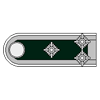Hello all.
I picked up a Tamiya T-55A kit pretty cheap, and found an okay priced Legend T-55AM2B conversion kit.
Seeing as I don't have any experience with Resin kits, what would be some tips from you guys? So far I know there has to be quite a bit of dry fitting, sanding and using CA glue.
Thanks.
Modeling in General
General discussions about modeling topics.
General discussions about modeling topics.
Hosted by Jim Starkweather
Working with resin, Tips?
Posted: Sunday, January 13, 2013 - 03:15 AM UTC

Jessie_C

Member Since: September 03, 2009
entire network: 6,965 Posts
KitMaker Network: 609 Posts

Posted: Sunday, January 13, 2013 - 03:20 AM UTC
Don't breathe the resin dust when you cut or sand it; it's carcinogenic. Small parts that won't be under any stress can be glued down with Future or clear paint instead of superglue. That way you can adjust their fit a little longer.
Posted: Sunday, January 13, 2013 - 04:10 AM UTC
wash model with ammonia and stiff brush before painting.
true for styrene models too I suppose, but resin kit makers tend to be less hygenic than factories, sometimes you will see mold release grease everywhere.
true for styrene models too I suppose, but resin kit makers tend to be less hygenic than factories, sometimes you will see mold release grease everywhere.
AJLaFleche

Member Since: May 05, 2002
entire network: 8,074 Posts
KitMaker Network: 2,574 Posts

Posted: Sunday, January 13, 2013 - 04:30 AM UTC
Quoted Text
Don't breathe the resin dust when you cut or sand it; it's carcinogenic.
WRONG, WRONG, WRONG!
Cured resin dust is an irritant as any particulate matter. In very large quantities, far beyond what you'll ever face in a conversion kit, it can be highly volatite as can any dust or fine particulate matter in large quantities in a confined (even factory sized) space.
Think I'm wrong?...Find me resin kit with a cancer warning on it. Ingesting lead is dangerous to children, and lead figures are no longer available. If resin dust were carcinogenic, you'd have lawywer ads on TV telling you to call them if you or a loved one had ever been exposed to resin dust and at some later date developed cancer.
For a full explanation, click on "HEALTH HAZARDS" at US Department of Labor (OSHA)
For some reason, the site won't allow me to post the full text of this sub-section.

spacewolfdad

Member Since: May 23, 2010
entire network: 642 Posts
KitMaker Network: 43 Posts

Posted: Sunday, January 13, 2013 - 05:11 AM UTC
Hi,
I always sand my resin parts using Wet and Dry paper WET. The dust becomes a slurry and you won't ingest it, getting rid of it is simple, just scrape the slurry into a plastic bag and wash the Wet and Dry paper in running water to clean it. If you have no intentions of using the paper again, just bin the lot (far safer really). Hope this helps.
All the best,
Paul
I always sand my resin parts using Wet and Dry paper WET. The dust becomes a slurry and you won't ingest it, getting rid of it is simple, just scrape the slurry into a plastic bag and wash the Wet and Dry paper in running water to clean it. If you have no intentions of using the paper again, just bin the lot (far safer really). Hope this helps.
All the best,
Paul

18Bravo

Member Since: January 20, 2005
entire network: 7,219 Posts
KitMaker Network: 981 Posts

Posted: Sunday, January 13, 2013 - 05:37 AM UTC
Quoted Text
Quoted TextDon't breathe the resin dust when you cut or sand it; it's carcinogenic.
WRONG, WRONG, WRONG!
Cured resin dust is an irritant as any particulate matter. In very large quantities, far beyond what you'll ever face in a conversion kit, it can be highly volatite as can any dust or fine particulate matter in large quantities in a confined (even factory sized) space.
Think I'm wrong?...Find me resin kit with a cancer warning on it. Ingesting lead is dangerous to children, and lead figures are no longer available. If resin dust were carcinogenic, you'd have lawywer ads on TV telling you to call them if you or a loved one had ever been exposed to resin dust and at some later date developed cancer.
For a full explanation, click on "HEALTH HAZARDS" at US Department of Labor (OSHA)
For some reason, the site won't allow me to post the full text of this sub-section.
This came up about a month ago in another thread and I happen to agree. The dust is an irritant, as is any dust, but your lungs eliminate it just like any other foreign matter. Still, not a good idea to breathe it in although for short cutting jobs I don't always grab my dust mask.
The wet sanding is good - I use that method when flattening the bottom of a piece that had a particularly large casting block.
As for removing those blocks, the best two tools you can have are a thin rotary saw on a Dremel, and a barrel shaped steel cutting tool. They make quick work of the largest blocks. Then you can finish it off with a chisel blade if needed, and sanding. Sprue cutters work very well for any blocks that will fit into them. Just make sure you protect yourself from flying debris.
In fact, you can see my review of the D9(R) to see what I mean.
Posted: Sunday, January 13, 2013 - 07:36 AM UTC
I use to work in the fibre glass trade in the UK until I was medically retired from the trade. resin dust is bad for you unless the glass fibre makes a major difference. sanding this material without taken the minimum of steps will harm you as it cuts when inhaled and we use to have very regular lung function tests amongst others.
I also know that a surgeon complained about the smell of resin when cutting me open 3 months after leaving the job, so as with most things take reasonable preventative measures such as a very good particle mask and I don't mean the throw away paper ones. 3M does some good masks which cost about £20 initially and then about £5 fora full set of filters, mine protects against vapours as well as particle and I use it when spray painting as well as sanding.
I also know that a surgeon complained about the smell of resin when cutting me open 3 months after leaving the job, so as with most things take reasonable preventative measures such as a very good particle mask and I don't mean the throw away paper ones. 3M does some good masks which cost about £20 initially and then about £5 fora full set of filters, mine protects against vapours as well as particle and I use it when spray painting as well as sanding.
Posted: Sunday, January 13, 2013 - 08:28 AM UTC
[quote]
WRONG, WRONG, WRONG!
The vapours from curing certain resins can be carcinogenic, but hopefully the hobby works with milder resins today. The dust from cured resin is not carcinogenic, but care should be taken with the dust from sanding. The same care should be taken when sanding your plastic kits. Dust in the lungs will not do any favours for your health. Some people can even get reactions on their skin with prolonged use. Wash your hands afterwards or even wear gloves if needed.
Quoted Text
Don't breathe the resin dust when you cut or sand it; it's carcinogenic.
WRONG, WRONG, WRONG!
The vapours from curing certain resins can be carcinogenic, but hopefully the hobby works with milder resins today. The dust from cured resin is not carcinogenic, but care should be taken with the dust from sanding. The same care should be taken when sanding your plastic kits. Dust in the lungs will not do any favours for your health. Some people can even get reactions on their skin with prolonged use. Wash your hands afterwards or even wear gloves if needed.

Posted: Sunday, January 13, 2013 - 01:29 PM UTC
Thanks for all the replies everyone. I'll keep that in mind. Just have to wait for my stuff to get here from South Korea. In the mean time, I have a maquette T-34-85 kit that came with a resin turret replacement. I'll practice with that and see how things go.
Posted: Monday, January 14, 2013 - 05:31 AM UTC
Quoted Text
resin dust is bad for you unless the glass fibre makes a major difference.
Actually the glass fibres make a huge difference and are the major factro in the cured fibreglass being potentially harmful. The liquid or uncured resin used in fibreglass is almost always either epoxy or polyester resin. The tan resin we are used to in model kits is polyeurethane resin - totally different.
While all liquid resins release some unwanted chemicals as they cure, in the cured state all of the resins are pretty inert posing only particulate hazards. Uncured, the liquid polyester resin is, by far, the most toxic and can have very long-term health effects if fully chemically compliant canister masks are not used during long term exposure to the liquid state.
In short, the resin used in modern aftermarket kist is pretty inert andsafe, just don't get a lot of it in your lungs. A dsut mask or sanding underwater is more than sufficient.
That said, some people do develop sensitivity to resins (or to chemicals in general) and have trouble using them thereafter. I have been making resin parts (for home use) and using resin parts for over 20 years and have no resin sensitivity issues. Again, if you are worried about it and are only using cured parts, minding the dust will be all you have to do, unless you have sensitivities going in, of course.
Paul
Anomander_Rake

Member Since: January 16, 2013
entire network: 6 Posts
KitMaker Network: 4 Posts

Posted: Wednesday, January 16, 2013 - 04:22 AM UTC
Wet sand as the others mentioned. Even pressure applied to the part while sanding otherwise one side will sand away quicker. Check the part often as the plug is sanded away to ensure one doesn't sand too far. I usually wear gloves because I don't like resin slurry on my hands.
Good Modeling
Good Modeling
mat

Member Since: November 18, 2003
entire network: 894 Posts
KitMaker Network: 127 Posts

Posted: Wednesday, January 16, 2013 - 04:44 AM UTC
just one thing, when you cut resin with it cracks like chocolate. This means the crack does not always go the way you think it goes. So if you remove fragile parts from the plug, better use a small saw or scribe it first with a sharp object. To remove the rest of the plug I try to avoid sanding, I rather scrape with a knife. It eliminates dust and clogging up your file (unles you use wet sandpaper but it is too messy for me). Sanding a flat surface always results in rounded corners at least a little bit, even if you are really careful, that is why a I rather use a knife.
 |






















